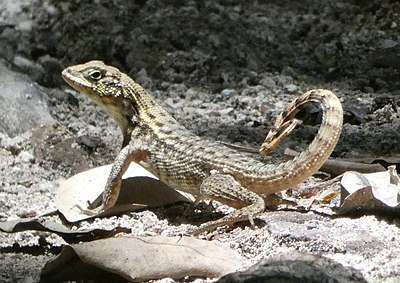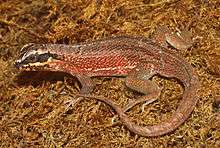Curly-tailed lizard
The curly-tailed lizards belong to the family Leiocephalidae. One of the defining features of these lizards is that their tail often curls over. They were previously regarded as members of subfamily Leiocephalinae within the family Tropiduridae. There are presently 29 known species, all in the genus Leiocephalus.
| Curly-tailed lizard | |
|---|---|
_(5-6-14)_ft_z_taylor%2C_key_west%2C_monroe_co%2C_fl_(14203556322).jpg) | |
| Leiocephalus carinatus | |
| Scientific classification | |
| Kingdom: | Animalia |
| Phylum: | Chordata |
| Class: | Reptilia |
| Order: | Squamata |
| Suborder: | Iguania |
| Family: | Leiocephalidae Frost & Etheridge, 1989 |
| Genus: | Leiocephalus Gray, 1827[1] |
Distribution
The curly-tailed lizards are native to the West Indies, with the extant (living) species in the Bahamas, Turks and Caicos, Cayman Islands, Cuba, Hispaniola (Haiti and the Dominican Republic) and nearby small islands.[2][3] Additionally, Leiocephalus carinatus and Leiocephalus schreibersii have been introduced to Florida.[4]
General anatomy
The curly-tailed lizards vary in size depending on species, but typically are approximately 9 cm (3.5 in) in snout-to-vent length. These lizards have no femoral pores, pterygoid teeth, or palatine teeth. Additionally, these lizards are observed to have overlapping scales.[2]
Behavior

The curly-tailed lizards mostly forage on arthropods like insects, but also commonly take flowers and fruits.[2][5] Large individuals will eat small vertebrates, including anoles.[5][6]
As suggested by their name, most species of this family often lift their tail and curl it. This is done both when a potential predator is present and when not present, although in some curly-tailed lizard species it increases when one is present. It shows the fitness of the lizard to a would-be predator and—in the case of an attack—draws attention to the tail, which increases the lizard's chance of escaping.[7][8] Although it has been suggested that it also functions as a territorial display,[4] studies have been unable to find support for this, as the tail curling does not change when another member of the same species is present.[8]
Conservation status
The conservation status of the species in this family varies greatly. Several species, for example Leiocephalus carinatus, are common and widespread. Others are rare and highly threatened, especially those restricted to a single small island or a single location on a larger island, like the critically endangered Leiocephalus (barahonensis) altavelensis from Alto Velo Island and critically endangered Leiocephalus onaneyi from Guantánamo Province in Cuba.[3] Primary threats to their survival are habitat loss (for example, expanding agriculture, charcoal production and grazing goats) and introduced predators (for example, small Indian mongoose).[9][10][11] Several species are already extinct.[12] Some of these are only known from fossil or subfossil remains and became extinct in the Pleistocene or pre-Columbian era, but others survived into recent history. Three species, Leiocephalus endomychus, Leiocephalus pratensis and Leiocephalus rhutidira, have not been seen since the 1960s and 1970s and are recognized as critically endangered, possibly extinct, by the IUCN. They are among the "most wanted" EDGE species.[10][11][13]
Newly discovered species
Lizards of this family are diurnal and mostly inhabit fairly open habitats in a generally well-studied part of the world. Consequently, the majority of the species and subspecies already were scientifically described several decades ago. In 2016, the first new curly-tailed lizard since the early 1980s was described. The species was found in the coastal dunes of Bahía de las Calderas in the southwestern Dominican Republic. This species differs from the rest within Leiocephalidae in that its bony parietal table is U-shaped versus V-shaped, the males have 3-4 enlarged post-postcloacal scales versus 2, and there are specific sexual dimorphism trails.[14]
Species and subspecies
_(8591588491).jpg)
_(8591588267).jpg)

The following species and subspecies, listed alphabetically by scientific name, are recognized as being valid by the Reptile Database.[15]
- Leiocephalus barahonensis Schmidt, 1921 – orange-bellied curly-tailed lizard
- Leiocephalus barahonensis altavelensis Noble & Hassler, 1933 – Alto Velo curly-tailed lizard (likely better regarded as a separate species)[16]
- Leiocephalus barahoensis aureus Cochran, 1934
- Leiocephalus barahonensis barahonensis Schmidt, 1921
- Leiocephalus barahoensis beatanus Noble, 1923
- Leiocephalus barahoensis oxygaster A. Schwartz, 1967
- Leiocephalus carinatus Gray, 1827 – Cuban curly-tailed lizard, northern curly-tailed lizard
- Leiocephalus carinatus aquarius A. Schwartz & Ogren, 1956
- Leiocephalus carinatus armouri Barbour & Shreve, 1935 – Little Bahama curly-tailed lizard
- Leiocephalus carinatus carinatus Gray, 1827
- Leiocephalus carinatus cayensis A. Schwartz, 1959
- Leiocephalus carinatus coryi Schmidt, 1936 – saw-scaled curly-tailed lizard
- Leiocephalus carinatus granti Rabb, 1957 – Cayman Brac curly-tailed lizard
- Leiocephalus carinatus hodsoni Schmidt, 1936
- Leiocephalus carinatus labrossytus A. Schwartz, 1959
- Leiocephalus carinatus microcyon A. Schwartz, 1959
- Leiocephalus carinatus mogotensis A. Schwartz, 1959
- Leiocephalus carinatus virescens Stejneger, 1901
- Leiocephalus carinatus zayasi A. Schwartz, 1959
- Leiocephalus cubensis (Gray, 1840) – Cuban brown curly-tailed lizard
- Leiocephalus cubensis cubensis (Gray, 1840)
- Leiocephalus cubensis gigas A. Schwartz, 1959
- Leiocephalus cubensis minor Varona & Garrido, 1970
- Leiocephalus cubensis pambasileus A. Schwartz, 1959
- Leiocephalus cubensis paraphrus A. Schwartz, 1959
- † Leiocephalus cuneus Etheridge, 1964 – Antiguan curly-tailed lizard (extinct, Pre-Columbian era, but might have survived into the 17th century)
- Leiocephalus endomychus A. Schwartz, 1967 – Hinche curly-tailed lizard (extinct?, last seen in 1976)
- † Leiocephalus eremitus (Cope, 1868) – Navassa curly-tailed lizard (extinct, 19th century)
- † Leiocephalus etheridgei Pregill, 1981 – Etheridge's curly-tailed lizard (extinct, Late Pleistocene)
- Leiocephalus greenwayi Barbour & Shreve, 1935 – East Plana curly-tailed lizard
- † Leiocephalus herminieri (A.M.C. Duméril & Bibron, 1837) – Martinique curly-tailed lizard (extinct, 19th century)
- Leiocephalus inaguae Cochran, 1931 – Inagua curly-tailed lizard
- † Leiocephalus jamaicensis Etheridge, 1966 – Jamaican curly-tailed lizard (extinct, Pleistocene or Holocene)
- Leiocephalus loxogrammus (Cope, 1887) – San Salvador curly-tailed lizard
- Leiocephalus loxogrammus loxogrammus (Cope, 1887)
- Leiocephalus loxogrammus parnelli Barbour & Shreve, 1935
- Leiocephalus lunatus Cochran, 1934 – Santo Domingo curly-tailed lizard
- Leiocephalus lunatus arenicolor Mertens, 1939
- Leiocephalus lunatus lewisi A. Schwartz, 1967
- Leiocephalus lunatus louisae Cochran, 1934
- Leiocephalus lunatus lunatus Cochran, 1934
- Leiocephalus lunatus melaenoscelis A. Schwartz, 1967
- Leiocephalus lunatus thomasi A. Schwartz, 1967
- Leiocephalus macropus (Cope, 1863) – Cuban side-blotched curly-tailed lizard
- Leiocephalus macropus aegialus A. Schwartz & Garrido, 1967
- Leiocephalus macropus asbolomus A. Schwartz & Garrido, 1967
- Leiocephalus macropus felinoi Garrido, 1979
- Leiocephalus macropus hoplites Zug, 1959
- Leiocephalus macropus hyacinthurus Zug, 1959
- Leiocephalus macropus immaculatus Hardy, 1958
- Leiocephalus macropus koopmani Zug, 1959
- Leiocephalus macropus lenticulatus Garrido, 1973
- Leiocephalus macropus macropus (Cope, 1863)
- Leiocephalus macropus phylax A. Schwartz & Garrido, 1967
- Leiocephalus macropus torrei Garrido, 1979
- Leiocephalus melanochlorus (Cope, 1863) – Tiburon curly-tailed lizard
- Leiocephalus melanochlorus hypsistus Schwartz, 1966
- Leiocephalus melanochlorus melanochlorus (Cope, 1863)
- Leiocephalus onaneyi Garrido, 1973 – Guantanamo striped curly-tailed lizard
- † Leiocephalus partitus Pregill, 1981 (extinct, Pleistocene or Holocene)
- Leiocephalus personatus (Cope, 1863) – Hispaniolan masked curly-tailed lizard
- Leiocephalus pratensis (Cochran, 1928) – Haitian striped curly-tailed lizard (extinct?, last seen in 1966)
- Leiocephalus pratensis chimarus A. Schwartz, 1979
- Leiocephalus pratensis pratensis (Cochran, 1928)
- Leiocephalus psammodromus Barbour, 1920 – Turks and Caicos curly-tailed lizard
- Leiocephalus psammodromus aphretor A. Schwartz, 1967
- Leiocephalus psammodromus apocrinus A. Schwartz, 1967
- Leiocephalus psammodromus cacodoxus A. Schwartz, 1967
- Leiocephalus psammodromus hyphantus A. Schwartz, 1967
- Leiocephalus psammodromus mounax A. Schwartz, 1967
- Leiocephalus psammodromus psammodromus Barbour, 1920
- Leiocephalus punctatus Cochran, 1931 – Crooked Acklins curly-tailed lizard
- Leiocephalus raviceps (Cope, 1863) – pallid curly-tailed lizard
- Leiocephalus raviceps delavarai Garrido, 1973
- Leiocephalus raviceps jaumei A. Schwartz & Garrido, 1968
- Leiocephalus raviceps kilinikowski A. Schwartz, 1960
- Leiocephalus raviceps raviceps (Cope, 1863)
- Leiocephalus raviceps uzzelli A. Schwartz, 1960
- Leiocephalus rhutidira A. Schwartz, 1979 – black-throated curly-tailed lizard (extinct?, last seen in 1978)
- Leiocephalus schreibersii (Gravenhorst, 1838) – red-sided curly-tailed lizard
- Leiocephalus schreibersii nesomorus A. Schwartz, 1968
- Leiocephalus schreibersii schreibersii (Gravenhorst, 1838)
- Leiocephalus semilineatus Dunn, 1920 – pale-bellied curly-tailed lizard
- Leiocephalus sixtoi Kohler, Bobadilla, & Hedges, 2016
- Leiocephalus stictigaster A. Schwartz, 1959 – Cuban striped curly-tailed lizard
- Leiocephalus stictigaster astictus A. Schwartz, 1959
- Leiocephalus stictigaster celeustes A. Schwartz & Garrido, 1968
- Leiocephalus stictigaster exotheotus A. Schwartz, 1959
- Leiocephalus stictigaster gibarensis A. Schwartz & Garrido, 1968
- Leiocephalus stictigaster lipomator A. Schwartz & Garrido, 1968
- Leiocephalus stictigaster lucianus A. Schwartz, 1960
- Leiocephalus stictigaster naranjoi A. Schwartz & Garrido, 1968
- Leiocephalus stictigaster ophiplacodes A. Schwartz, 1964
- Leiocephalus stictigaster parasphex A. Schwartz, 1964
- Leiocephalus stictigaster septentrionalis Garrido, 1975
- Leiocephalus stictigaster sierrae A. Schwartz, 1959
- Leiocephalus stictigaster stictigaster A. Schwartz, 1959
- Leiocephalus varius Garman, 1887 – Grand Cayman curly-tailed lizard
- Leiocephalus vinculum Cochran, 1928 – Cochran's curlytail lizard
Nota bene: A binomial authority or trinomial authority in parentheses indicates that the species or subspecies was originally described in a genus other than Leiocephalus.
References
- "Leiocepalus ". Dahms Tierleben. www.dahmstierleben.de.
- J., Vitt, Laurie (2014). Herpetology : an introductory biology of amphibians and reptiles. Caldwell, Janalee P. (4th ed.). Amsterdam. ISBN 9780123869197. OCLC 839312807.
- Hedges, B. "All Islands". CaribHerp. Retrieved 2 July 2019.
- Conant, R.; J.T. Collins (1998). A Field Guide to the Reptiles and Amphibians of Eastern and Central North America (3 ed.). pp. 244-246. ISBN 978-0395904527.
- Kircher, B.L.; C.D. Robinson; M.A. Johnson (2014). "Herbivory in the Northern Curly-tailed Lizard (Leiocephalus carinatus)". Caribbean Herpetology. 50: 1–2. doi:10.31611/ch.50.
- Steinberg; Losos; Schoener; Spiller; Kolbe; Leal (2004). "Predation-associated modulation of movement-based signals by a Bahamian lizard". PNAS. 11 (25): 9187–9192. doi:10.1073/pnas.1407190111. PMC 4078856. PMID 24843163.
- Cooper, W.E. (2007). "Escape and its relationship to pursuit‐deterrent signaling in the Cuban curly‐tailed lizard Leiocephalus carinatus". Herpetologica. 63 (2): 144–150. doi:10.1655/0018-0831(2007)63[144:EAIRTP]2.0.CO;2.
- Kircher, B.K.; M.A. Johnson (2017). "Why do curly tail lizards (genus Leiocephalus) curl their tails? An assessment of displays toward conspecifics and predators". Ethology. 123 (5): 342–347. doi:10.1111/eth.12603.
- Fong, A. (2017). "Leiocephalus onaneyi". IUCN Red List of Threatened Species. 2017: e.T178278A7512731. doi:10.2305/IUCN.UK.2017-2.RLTS.T75310301A75607524.en.{{cite iucn}}: error: |doi= / |page= mismatch (help)
- "57. Central Haitian Curlytail". EDGE species. Retrieved 2 July 2019.
- "73. Lapierre Curlytail Lizard". EDGE species. Retrieved 2 July 2019.
- Meiri, S.; et al. (2017). "Extinct, obscure or imaginary: The lizard species with the smallest ranges" (PDF). Diversity and Distributions. 24 (2): 262–273. doi:10.1111/ddi.12678.
- "75. Atalaye Curlytail Lizard". EDGE species. Retrieved 2 July 2019.
- Köhler, Gunther; Bobadilla, Marcos J. Rodríguez; Hedges, S. Blair (2016-06-13). "A new dune-dwelling lizard of the genus Leiocephalus (Iguania, Leiocephalidae) from the Dominican Republic". Zootaxa. 4121 (5): 517–32. doi:10.11646/zootaxa.4121.5.2. ISSN 1175-5334. PMID 27395240. S2CID 9386834.
- Leiocephalus at the Reptarium.cz Reptile Database. Accessed 2 July 2019.
- Inchaustegui, S.; Landestoy, M.; Powell, R. & Hedges, B. (2016). "Leiocephalus altavelensis". IUCN Red List of Threatened Species. 2016: e.T178278A7512731. doi:10.2305/IUCN.UK.2016-3.RLTS.T75306189A75607464.en.{{cite iucn}}: error: |doi= / |page= mismatch (help)
Further reading
- Gray JE (1827). "A Description of a new Genus and some new species of Saurian Reptiles; with a Revision of the Species of Chameleons". Philosoph. Mag. Ann. Chem. Math. Astron. Nat. Hist. Gen. Sci. 2 (9): 207-214. (Leiocephalus, new genus, p. 207).
- Schwartz A, Thomas R (1975). A Check-list of West Indian Amphibians and Reptiles. Carnegie Museum of Natural History Special Publication No. 1. Pittsburgh, Pennsylvania: Carnegie Museum of Natural History. 216 pp. (Leiocephalus species, L. barahonensis – L. viniculum, pp. 126–140).